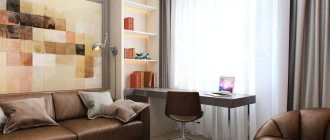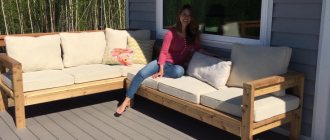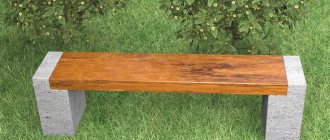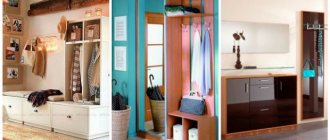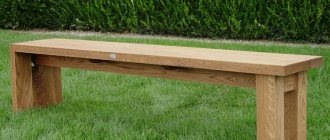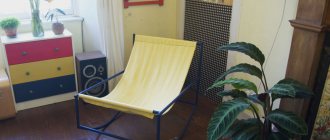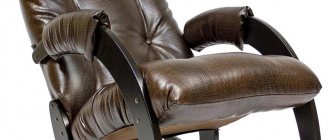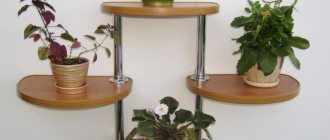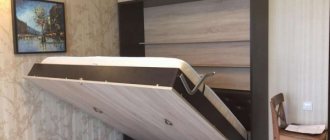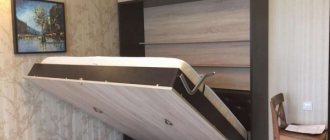Furniture in the living room includes upholstered furniture - a sofa, armchairs, cabinets - cabinets, TV stands, usually a dining area or at least a coffee table. But today, a shelving unit in the living room more often replaces a closet, a counter, and shelves. Modern models are extremely diverse and come in a variety of styles.
Features of the rack
A rack is equipment that is a rack with shelves and is designed to store a wide variety of items. Racks are much more often used in work and office spaces, and especially in warehouses. In dwellings there are only a few options: household and exhibition.
- Household shelving for books and clothes in the living room is popular due to its high compactness . You can place a lot of things on the tiers of the rack, but at the same time follow a certain order of placement, which makes it much easier to use.
- Exhibition - types of showcase . The smallest models of this kind are installed in apartments. They include special compartments designed to display crafts, beautiful dishes, and collectibles. Often such racks are equipped with mirrored shelves and lighting.
The photo shows stylish glass shelving in the living room.
The design can include any number of tiers and compartments, fill a wall up to the ceiling, or occupy at least 3 walls in a row. Shelves can be easily combined with other pieces of furniture.
Varieties of racks by shape and size
There are several types of racks:
- Frame - lightweight structures consisting of several shelves fastened with racks.
- In the form of a wall - multi-tiered shelves, with a back wall and closing doors, can also be divided into cells. There are shelves with a special place for a TV.
Shelving dimensions:
- Width – typical size is 90 cm, the wall can be 2-3 m wide.
- Height - 1.8 m, but there are others.
- The depth of the shelves is 45 cm, the lower ones can be up to 30 cm deep.
- The distance between shelves is from 35 to 40 cm.
In addition, racks can be divided into classes:
- Built-in. Attached to the walls of niches. Due to their compactness and ergonomics, they are often used in kitchens and office spaces.
- Standard straight. They look like regular cabinets, but without front doors.
- Angular. Compared to straight ones, they have more usable area and are suitable in cases where you need to place a lot of things.
- Hanging. Lightweight designs with intricate shapes.
Racks can have both symmetrical and asymmetrical shelves in a variety of configurations: rectangular, square, straight, curved and even zigzag.
Stepped type shelving is a rather unusual choice; such models consist of several modules that are installed in ascending order in the form of a ladder.
Such designs are usually open, do not have a back wall and can fit into any modern room design.
Narrow horizontal and vertical designs are very popular. They save a lot of space and look minimalistic.
U-shaped models are very roomy and compact. They are used to frame doorways, sofas, beds and other furniture elements.
Product benefits
Shelving system options for the living room have many advantages:
- the low weight of such furniture simplifies installation and significantly reduces the time it takes to furnish a room;
- a product of even the most complex shape remains mobile and can be easily moved to any other place;
- it is very easy to find any items on the open shelves of the rack;
- such designs are very practical. Shelves and compartments can be of different sizes, which allows you to increase the functionality of the product. For example, create a shelf for a TV in the living room;
- Open shelving for the living room makes ideal partitions. They delimit zones, but do not block the perspective of the room and do not visually reduce the living room area. In addition, the product remains functional: you can store any things on the shelves;
- racks are more economical than wall modules or full-fledged cabinets. Since racks are rarely equipped with doors, there is no need for space to open them, and the height of the structure allows you to place a large number of things;
- With the help of a shelving unit you can add personality to your living room.
The product also has some disadvantages:
- open shelves imply keeping things on them in ideal or at least relative order;
- Some items cannot be stored this way.
Practical tips for making
In the presented photos you can see a self-made rack installed. It fits perfectly into the environment, suits the needs of the family and is made from affordable materials.
To make such furniture yourself, you need to follow simple tips from our experts:
- Determine the parameters of the room, the purpose of the shelves, their strength, choose the material. Depending on the room: corridor, living room, kitchen or bedroom, the functionality and appearance of the structure will change.
- Creating a drawing. Ready-made diagrams can be downloaded from the Internet, magazines, or, having certain knowledge and skills, you can draw a drawing yourself. The dimensions of the room will be required: ceiling height, wall width, cell depth. Tip: if you make marks on the surface of the walls in full size, then this technique will significantly facilitate the construction of the drawing. Diagrams of shelving shelves and options for their location, various models of furniture can be found in specialized literature.
- Installation of the product: assembly on site or installation of a finished structure. Power tools required (jigsaw, drill, screwdriver), hammer, nails, sandpaper, pencil, material. Wooden beams, chipboard, metal profiles, remains of containers, boxes, crates, plastic and glass panels, bricks, and old books are suitable.
- Decoration of the finished product. Wooden shelves are easier to finish. For colorful decor, we can recommend painting, varnishing, decoupage, colored edges, burning, and curly edges.
Advice: Even if you have a precise eye and this is not the first time you have made furniture yourself, it is better to prepare a schematic drawing in advance. Including all parts, fasteners, and their sizes.
Types of furniture
Modern shelving for the living room is not only practical, but also decorative, but the point here is not in the design or even in the material of manufacture, but in the design of the product. Although this is very simple furniture, there are many options for its implementation.
Rack design
Shelving for the living room in a modern style comes in 2 main types.
- Frame - a classic option, which is a rack with a row of shelves . As a rule, it has shelves or sections of the same size, but this is not necessary. There are many original design versions, where the shelves differ in height and length. Frame products can have a variety of sizes. The simplest and most famous option is a shelf for the living room, corner or linear. Essentially, this is 1 section with shelves that takes up minimal space. However, a frame product can occupy at least 3 walls in a room and serve as a partition.
- An enclosed structure for a home includes a back wall and, in some cases, doors . Sometimes this option can replace a wall in the living room and includes a special section for the TV.
The photo shows beautiful shelving in the living room.
- Built-in rack - is a wall niche in which shelves are fixed . Such a model can be purely utilitarian and hidden behind a sliding door, or have decorative value: in this case, the shelves are equipped with lighting. For example, a closed and built-in design allows you to vary not only the sizes of shelves and sections, but also their shape.
Shelving configuration
The popularity of such furniture is due not only to its compactness, but also to the ability to install it literally anywhere in the room. Based on this feature, two types of construction are distinguished.
- Linear shelving - placed along one wall or used as a partition. In the latter case, it includes only open shelves and sections.
- Corner - shelving and bookcases for the living room require the compartments to be connected in such a way that the structure can be installed in the corner of the room. This option is very popular, as it allows you to use the corner space, which is usually “walking”.
The dimensions of linear and corner shelving are not limited in length or height.
- Ladder rack - in this case there are no side posts, and the shelves are fixed on the back wall. In this case, the shelves from bottom to top decrease in length and form a kind of ladder.
- Suspended - a console version in which there is no contact with the floor. The model is fixed on the wall. It can be either angular or linear and include shelves of different types.
The photo shows the original shelving in the living room.
- The cylinder is a practical design suitable for spacious rooms. The rack is a rotating structure with rounded shelves. This option is very convenient when combining a living room and a study, as it allows you to access any material and things without getting up from your seat, but by rotating the rack.
Shelf configuration
A shelving unit in a modern style living room is usually made using new furniture design methods. This also applies to shelves.
- The standard option - shelves or compartments - have a shape close to a square, with the same dimensions. The convenience of such furniture lies in its versatility. Unified dimensions allow you to select models for the living room of the most complex configuration.
- A shelf for a shelving unit in the living room can have different sizes . A combination of shelves of different lengths and even heights allows you to structure the wall space and visually change the proportions of the room. Less common, but there are also models with shelves of different depths. This option is very convenient when organizing a work office, as it can be easily combined with a desk - desk or computer.
- Another interesting option is placing shelves for shelving in the living room at an angle . Diamond-shaped sections and tiers amazingly “revive” the interior. The photo shows such a solution.
- There are also more spectacular design products in which the shelves have the shape of a triangle, hexagon, rounded contours and even a circle.
The photo shows designer shelving in the living room.
You can vary not only the size and shape of the shelves, but also their actual combination with each other. Based on this feature, two types of products are distinguished: symmetrical and asymmetrical.
- In the first case, any type of shelves and sections are placed symmetrically , relative to the axis of the structure or center, such as in TV shelves in the living room. This solution is typical for products in classical styles or their imitations.
- Asymmetrical - in this case, sections of both different and identical sizes are placed asymmetrically, but in a certain order . This option is more interesting, as it allows you to structure the room arbitrarily, without taking into account its configuration. If you need to zone the living room, this option is more effective.
Step-by-step instruction
Step 1. Cut the lining, adjusting its length in accordance with the length of the rack. If the planks you bought are longer than the width of the structure, then the excess needs to be carefully cut off.
Trimming parts according to the length of the future rack
Step 2. Treat the surface of wooden products with impregnation, thereby protecting them from external factors.
Next, protective impregnation is applied
Impregnation application process
Step 3. Paint each of the structural elements. To save time, you can lay several planks together at once and paint them as one surface. Then turn them over to the other side and continue painting.
Convenient to process several boards at a time
Step 4. Once all the parts are painted, leave them outside until completely dry. The impregnation does not smell very pleasant, so it is not recommended to dry painted products indoors.
Wait until the wood is completely dry
Step 5. Make marks on the bars in the places where future shelves should be located. Then install metal corners in the designated places. If you have a screwdriver in the house, this will significantly speed up the work process.
Metal corners fixed
Step 6. Install the lower horizontal elements to create an “H” shaped structure. As a result, you need to make four such products.
There should be 4 such elements
On a note! At first, the installation of second horizontal lines must be performed only in the outermost structures. It is necessary to start installing the remaining horizontals a little later, when the bottom shelf is ready.
Step 7. This is what the rack design should look like at this stage of manufacturing. She is not very attractive yet, but this can all be fixed.
Making a rack with your own hands
Step 8. Fasten the first shelf, or rather, the boards of the first shelf to the horizontal bars. It is not necessary to use screws for this - you can get by with ordinary nails.
Installing the first shelf using nails
Step 9. Start nailing the outermost board first, which will be visible to everyone. Here it is necessary to choose high-quality material, without defects. After installing all the elements, the bottom shelf will be ready.
Finished bottom shelf of the rack
Step 10. Make small stands for the legs of the structure being manufactured, thereby protecting the floor covering from mechanical damage. In addition, if you add a few laminate scraps, they can be used to level the rack in the future.
Stands for shelving legs
Step 11 . Proceed to make the second shelf of the rack. All actions should be similar, only at this stage of work you can immediately install the upper horizontal lines.
Installation of the second shelf
Step 12 . Make sure that the shelf, or rather the planks from which it is made, lie on all horizontal lines. Ideally, all these elements should be in the same plane.
The boards must lie on all horizontal lines
Step 13 . If large gaps appear between the shelves and horizontal bars, level them using small pieces of laminate. Simply cut out a strip and place it under the board in the desired location.
This gap needs to be corrected
Step 14: Do not screw the side of the square that attaches to the upright too tightly. When eliminating too large gaps, the horizontal will need to be moved a little. Once everything is level, screw the fasteners as tight as possible.
One part of the corner is not fully screwed
Step 15 . Install the last shelf, making it slightly wider than the others. If the first two shelves use 5 planks, then the top one should have 6. This will increase the strength of the entire structure.
DIY rack is ready
Additionally, you can make a small ladder if the rack is high enough. The design of the staircase may vary. Now everything is ready and you can enjoy the result of the work done.
Materials for production
Shelving in the living room interior serves as a structure and background rather than as an accent. Most often, the same materials are used for their production as for the production of other living room furniture, but there are exceptions.
- Wood is the most beautiful material for furniture . The wood has a rich color and texture, is easy to process, lasts a very long time, and is incredibly pleasant to the touch. Any design options are made from wood. However, the material is most suitable for closed shelving, where there are more possibilities for decoration.
The photo shows wooden furniture for the living room.
- MDF, chipboard, plywood - a more budget option . Chipboards of different densities serve as an excellent basis for all types of furniture. By themselves they are not attractive. The resemblance to wood of any species is given by the finishing: veneer - a cut of natural wood, PVC film, resin-impregnated kraft paper, etc. Since the racks are not subject to high loads, the strength of this material is more than enough. Ease of processing and cutting allows you to design furniture of any, even the most complex shape and configuration.
The combination of MFD and chipboard with other materials – glass, metal, plastic – is very interesting. This allows you to diversify the decor of furniture.
The photo shows a shelving unit for the hall.
- Stylish glass shelving for the living room is one of the most spectacular options . Glass shelves are fixed to a metal or wooden frame. Impact-resistant glass is used for furniture, so there is no need to worry about damaging the rack. Often the racks are made entirely of glass. Such furniture literally “dissolves” against the background of the wall and creates a feeling of airiness.
The big advantage of this model is the transparency of the shelves and the ability of glass to reflect light. The design not only does not reduce the perspective of the room, but also visually increases the space. This quality is especially valued in high-tech and techno styles, where preference is given to material with a reflective surface.
- Metal is used as a material for the frame . The steel used is polished, chrome-plated, matte, aluminum, brass, sometimes even bronze. Shelves are made of glass or wood. However, for styles such as loft, techno or industrial, more exotic projects are carried out. In these cases, the rack is made entirely of metal pipes, including partitions for shelves. Typically, such designs are used for books, since objects with a smaller area require a more voluminous base.
- A plasterboard shelving unit in the living room is a relatively new solution, since such material has not been used in apartment decoration for a long time. Only a stationary structure can be made from plasterboard, since the material is not designed for heavy loads. Even the owner of the apartment can make a shelving unit in the living room from plasterboard with his own hands, if he has some skills.
Several options are available:
- the simplest is plasterboard sections in a niche . An undoubted advantage of the solution is the ability to make shelves of any shape and configuration, since they have the most reliable fastening - with all three walls of the niche;
- volumetric rack - mounted on the wall and, in fact, forms one whole with it . Typically, such a rack is not so much practical as decorative, since it is more convenient to make wide and high shelves from plasterboard. The design can be easily combined with individual pieces of furniture or equipment, for example, a TV stand and screen;
- shelving partitions for the living room made of plasterboard are the most effective option . Such a product can be given the most bizarre and unusual configuration and give different shapes to any elements. A shelving unit can enclose part of a room, or it can form a wall between zones with an arched entrance, for example. The photo shows options for plasterboard shelving for the living room.
The choice of material for furniture is determined by the style of the living room and the rest of the furniture. As a rule, the materials of the shelving and other pieces of furniture should match, but glass and drywall are an exception. Glass can be combined with any material, and drywall can be finished in any way.
Homemade shelving decor options
The shelving can be left unchanged after assembly, especially if solid wood is used. Such designs have a pleasant design with a natural shade (walnut, wenge, oak). However, craftsmen often additionally decorate finished structures in one of the following ways:
- Stencil painting using acrylic paints.
- The use of special PVC films that imitate various materials (stone, brickwork, gypsum panels).
On the facades you can hang beautiful souvenirs made by yourself (papier-mâché plates with original painting).
Stylistic decisions
The rack is a very simple design and, as a rule, is designed quite simply. However, this option is so versatile that it can be easily combined with pieces of furniture of any style.
- For classic and baroque shelving, they are made of solid wood or MDF, imitating an expensive type of wood . The dimensions of the shelves in this design have standard dimensions, always the same. Shelves and sections - open and closed, are placed strictly symmetrically - this is a mandatory requirement.
The decor in such cases is represented by applied carved elements, if the overall design of the living room suggests the possibility of carving. A combination of wood and glass is possible. In Baroque and Renaissance it is allowed to use glass with a sandblasted pattern.
- In modern style, stylish glass shelving for the living room is decorated with colored glass . In the Art Nouveau style, plasterboard structures are especially often made, since this style involves asymmetry and allows for the most extravagant shape of products.
- Constructivism allows you to combine shelves and compartments of various sizes, including those with different depths . Symmetry is optional. However, the compartments must be of the correct rectangular shape. A constructivist style shelving system allows you to structure the space very effectively.
- A techno style rack allows you to use unusual materials - plastic, metal, glass. At the same time, the shape of the shelves and the sections themselves is strictly rectangular; other shapes and configurations are not allowed.
- High-tech involves both strict and curvilinear forms . The dimensions of the shelves are kept the same, but the outlines can be very different. The furniture is made of wood, glass and metal. In this case, the glass must be either transparent or frosted; colored glass is not allowed. Metal – steel and aluminum, polished or matte.
The photo shows shelving in the room.
- Entirely metal shelving in the living room is often used in loft and industrial settings , where preference is given to industrial materials. The basis of such a product is usually a metal pipe. You can use metal elements of mechanisms to decorate the rack.
- In styles such as vintage and fusion, you can combine pieces of furniture in different styles . Simple shelving in the constructivist style, built between elements in the neo-baroque or neoclassical style, looks modern and unusual. An asymmetrical, complex partition in the Art Nouveau style goes well with the high-tech design, acting as a kind of accent.
Shelving in the living room is an optional piece of furniture, but very practical and convenient. The rack, despite its compactness, allows you to save an extraordinary amount of things. At the same time, the design is an effective interior tool.

